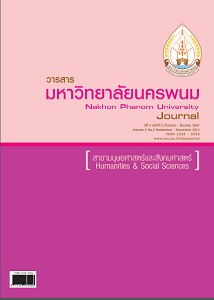การวิจัยและพัฒนาหลักสูตรสถานศึกษากลุ่มสาระการเรียนรู้สังคมศึกษา ศาสนา และวัฒนธรรมรายวิชาเพิ่มเติมสาระท้องถิ่น เรื่องประเพณีที่สำคัญ ของบ้านท่าแร่สกลนคร สำหรับนักเรียนชั้นประถมศึกษาปีที่ 6
Main Article Content
บทคัดย่อ
การวิจัยครั้งนี้มีวัตถุประสงค์เพื่อ 1) พัฒนาและหาประสิทธิภาพหลักสูตรสถานศึกษากลุ่มสาระการเรียนรู้สังคมศึกษา ศาสนา และวัฒนธรรมรายวิชาเพิ่มเติมสาระท้องถิ่นเรื่องประเพณีที่สำคัญของบ้านท่าแร่สกลนคร สำหรับนักเรียนชั้นประถมศึกษาปีที่ 6 ที่มี ประสิทธิภาพตามเกณฑ์ 80/80 2) เปรียบเทียบผลสัมฤทธิ์ทางการเรียนของนักเรียนระหว่างก่อนและหลังเรียนด้วยหลักสูตรที่สร้างขึ้น 3) ศึกษาเจตคติต่อการเรียนเรื่อง ประเพณีที่สำคัญของบ้านท่าแร่สกลนคร และ 4) ประเมินความเหมาะสมในการใช้หลักสูตรของ นักเรียน 5) ทดลองระหว่างปีการศึกษา 2552–2556 กลุ่มตัวอย่างที่ใช้ในการวิจัยเป็นนักเรียนชั้นประถมศึกษาปีที่ 6 โรงเรียนท่าแร่วิทยา สำนักงานเขตพื้นที่การศึกษาประถมศึกษาสกลนคร เขต 1 จำนวน 30 คน ซึ่งได้มาจากการสุ่มแบบแบ่งชั้น เครื่องมือที่ใช้ในการวิจัย ได้แก่ 1) หนังสืออ่านเพิ่มเติม จำนวน 18 เรื่อง 2) แผนการจัดการเรียนรู้ จำนวน 18 แผนใช้เวลา 30 ชั่วโมง 3) แบบทดสอบวัดผล สัมฤทธิ์ทางการเรียน จำนวน 40 ข้อ มีค่าความยากตั้งแต่ 0.27-0.80 ค่าอำนาจจำแนกตั้งแต่ 0.21-0.79 ค่าความเชื่อมั่นเท่ากับ 0.88 4) แบบวัดเจตคติต่อการเรียน จำนวน 20 ข้อ มีค่าอำนาจจำแนกตั้งแต่ 0.35-0.80 ค่าความเชื่อมั่นเท่ากับ 0.91 และ 5) แบบประเมิน ความเหมาะสมในการใช้หลักสูตรของนักเรียน จำนวน 10 ข้อ สถิติที่ใช้ในการวิเคราะห์ข้อมูล ได้แก่ ร้อยละ ค่าเฉลี่ย ส่วนเบี่ยงเบน มาตรฐาน และการทดสอบที (t-test) ผลการวิจัยพบว่า 1) หลักสูตรที่พัฒนาขึ้นมีความเหมาะสมอยู่ในระดับมากที่สุด (x = 4.59) และ มีประสิทธิภาพเท่ากับ 87.20/81.25 ซึ่งเป็นไปตามเกณฑ์ที่กำหนด 2) ผลสัมฤทธิ์ทางการเรียนของนักเรียนหลังเรียนสูงกว่าก่อนเรียน อย่างมีนัยสำคัญทางสถิติที่ระดับ .01 3) เจตคติของนักเรียนที่มีต่อการเรียนเรื่อง ประเพณีที่สำคัญของบ้านท่าแร่สกลนครโดยภาพรวม อยู่ในระดับมาก (x = 4.39) 4) ความเหมาะสมในการใช้หลักสูตรในทัศนะของนักเรียน โดยภาพรวมอยู่ในระดับมากที่สุด (x = 4.55) 5) การนำหลักสูตรไปใช้ต่างโรงเรียนนักเรียนมีความคิดเห็นต่อความเหมาะสมในการใช้หลักสูตร โดยภาพรวมอยู่ในระดับมากที่สุด (x = 4.60) และผลสัมฤทธิ์ทางการเรียนของนักเรียนหลังเรียนสูงกว่าก่อนเรียนอย่างมีนัยสำคัญทางสถิติที่ระดับ .01
The purposes of this study were: 1) to develop and examine the efficiency of a school curriculum for the social studies, religion and culture strand on an additional course of local substance entitled ‘Important Traditions of Ban Tharae, Sakon Nakhon’ for Prathom Suksa 6 students based on the 80/80 criterion, 2) to compare the students’ learning achievements before and after learning with the developed curriculum, 3) to investigate the students’ attitude towards learning on important traditions of Ban Tharae, Sakon Nakhon, 4) to evaluate the appropriateness in using the curriculum among the students, and 5) to do an experiment in a period from academic year of 2009 to academic year of 2013. A sample used was Prathom Suksa 6 students at Tharae Withaya School under the Office of Sakon Nakhon Primary Education Service Area 1 as selected by stratified random sampling. The instruments used were: 1) supplementary reading books of 18 stories, 2) 18 lesson plans for 30 hours, 3) a 40–item learning achievement test whose difficulty values ranged between 0.27 and 0.80, discrimination power values between 0.21 and 0.79 and reliability value was 0.88, 4) an attitude assessment form consisting of 20 items, whose discrimination power values ranged between 0.35 and 0.80 and reliability value was 0.91 and 5) a 10-item form for assessing the appropriateness of using the course curriculum for students. Statistics used in data analysis were percentage, mean, standard deviation, and t-test.The findings were : 1) the developed curriculum had the highest level of appropriateness (x = 4.59) and had efficiency of 87.20/81.25 which met the criterion specified; 2) the students’ learning achievement after using the developed curriculum was significantly higher than that before using the developed curriculum at the .01 level; 3) the students’ attitude towards learning on important traditions of Ban Tharae, Sakon Nakhon as a whole was at high level (x = 4.39); 4) the appropriateness of using the developed curriculum as a whole was at the highest level (x = 4.55); and 5) when the developed curriculum was used in other schools, the appropriateness as a whole which was evaluated by students was at the highest level (x = 4.60) and the students’ learning achievement after using the curriculum was significantly higher than that before using the curriculum at the .01 level.


